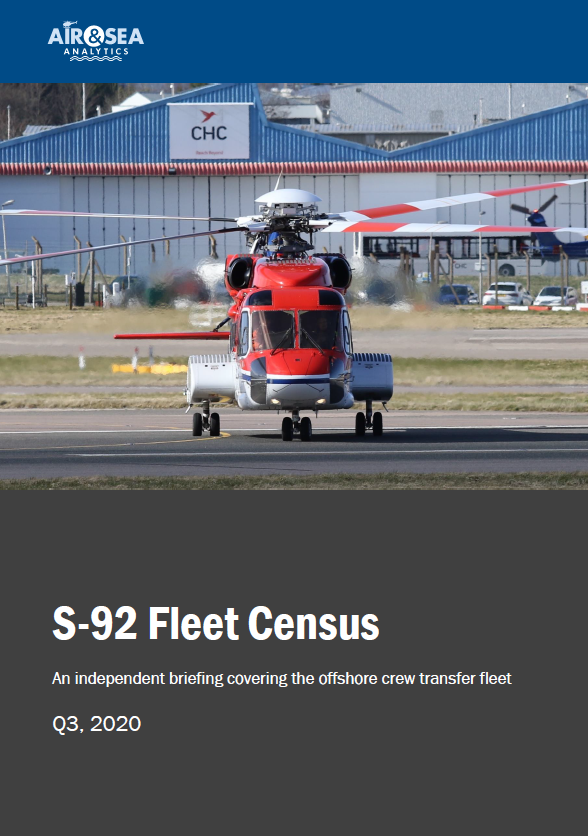“The S-92 will endure as an industry stalwart”
This week we are delighted to speak with Con Barber, Chief Investment Officer of Macquarie Rotorcraft. Con has more than twenty years experience in the aviation sector, filling a wide variety of technical, project management and strategic management roles. Con offers his perspective on the competitiveness and longevity of the S-92, asset valuation and the longer-term potential for rotorcraft in offshore markets.
Con – thank you for taking the time to speak with us. What does the Macquarie rotorcraft portfolio look like today in terms of number / value of assets under management? What’s the relative exposure to sectors such as oil & gas, EMS etc?
The Macquarie Rotorcraft (MRL) portfolio consists of over 150 aircraft with an approximate 3:1 split between Oil & Gas (O&G) and non-O&G end-use. We offer a full range of helicopter finance solutions so the aircraft are a mix of operating lease, finance lease and loan collateral aircraft.
A large part of MRL’s portfolio was acquired through the Waypoint bankruptcy (Q1/2019) and we are pleased with how the portfolio has performed through the 18 months since acquisition. We’ve optimised the portfolio by divesting non-core assets and extending the leases of core aircraft that we want to keep in the portfolio. Overall, we’ve made significant progress towards achieving a well balanced portfolio with the right mix of assets and end-uses. Portfolio optimisation is always a work in progress but we’re comfortable with our current fleet.
What do your clients look for when they come to Macquarie? Is there genuine differentiation amongst lessors?
Prior to the O&G downturn, some industry participants might have viewed operating leases as a quasi-commoditised product and didn’t significantly distinguish between lessors beyond the commercial terms of the lease. However, in light of the recent challenges faced by the industry, our clients are increasingly voicing their desire to have a strong financial partner, with industry experience and a long-term view. MRL certainly fits the bill. MRL sits on the Macquarie Group balance sheet and isn’t reliant upon third-party financing, which creates operating flexibility, increased responsiveness and long-term resilience.
MRL’s value proposition extends beyond our financial strength. MRL also has an operational mindset with a core staff of helicopter and leasing veterans who understand the asset and the industry. This experience allows MRL to bring holistic customer focused solutions to our clients. The congruence of industry knowledge, experience and financial strength is a genuine differentiator which is valued by our customers.
Andes H145 provided on lease by MRL and deployed in Peru on a copper mining projected operated by Las Bambas. Image: MRL
We are starting to see activity coming back, but I think it’s fair to say the offshore oil industry remains challenged. The mobile drilling rig business has scrapped a quarter of the fleet (over 250 rigs) since 2015 yet is still only seeing 67% utilisation. The S-92, looking at it as an asset class in oilfield services is currently at 82% utilisation (% of fleet active). Macquarie are the second-largest lessor. What’s your headline view of the S-92 in terms of its attractiveness as an asset class? How does it compare to other aircraft in your portfolio?
We have heard the S-92 called the “workhorse” among helicopters servicing the offshore industry, for good reason. It has a solid history for safely transporting crew which provides a level confidence in owning the asset. Considering the degree of distress in the offshore Oil and Gas market since 2014, S-92 utilisation, at 82%, is impressive. In fact, we believe that the true utilisation may be closer to 90% as a number of the units counted as “inactive” are, in reality, beyond economic return to service and will be incrementally removed from the global fleet. Considering the high utilisation, we are confident that a small demand uptick will lead to supply and demand balance in line with recovering IOC CAPEX.
A Macquarie S-92 on lease to Babcock MCS. Image: MRL
The salient question is the extent to which the S-92 will benefit from IOC CAPEX restoration. Assuming market efficiency, our analysis of S-92 operating economics gives us confidence. Consider a typical 130 nautical mile offshore mission profile (a profile MRL modelled to calculate S-92 operating economics on a recent tender); on such a profile, the total S92 operating cost (inc. lease rate) is c. $2.60 per seat mile, which assumes standard atmosphere, maximum load factor and standardised operating assumptions (including fuel reserves and OEI performance). These figures represent a 10% discount to the seat mile operating cost (inc. lease rate) compared to the best alternate helicopter, which is an impressive result for the S-92. Ultimately, once the drag of a c. 20 unit oversupply is removed from the market, price elasticity and S-92 operating economics should justify a material increase in S-92 lease rates in the mid term.
In summary, 1) we are confident that the S-92 will endure as an industry stalwart, 2) a restoration of IOC CAPEX over the next 36 months should positively impact S-92 demand, 3) S-92 operating economics justify a material lease rate increase above current market rates once the supply overhang is cleared, and 4) our analysis suggests that +25% is the S-92 lease rate threshold which justifies a switch to the Super Medium category and we do not expect to see broad-based Super Medium market penetration until S-92 rates approach this threshold. In consideration of these factors, MRL is confident in the S-92 and it will remain as a core asset in our portfolio
We’ve been through the latest earnings season and once again 'hydrocarbons' seems to be a dirty word even for some of the largest oil majors. Are you looking ‘beyond petroleum’… for example - are you looking at potentially finding work for S-92s in secondary markets such as military, crew training, other utility, VIP etc? Are S-92 prices now at a level where it makes sense to reconfigure?
The IOCs are pivoting to a mix of hydrocarbons and renewables, but oil will remain as an integral part of the broad energy mix for the foreseeable future. The transition to renewables will happen over time, which will catalyse exciting new growth opportunities for our industry. Consider, for example, the impending Final Investment Decision (FID) by Equinor and SSE on the Dogger Bank project, the World’s largest wind farm, which will involve a $11bn investment (2020-26) in the North Sea. CAPEX on offshore renewables, like Dogger Bank, have many synergies with offshore OGP which MRL is poised to exploit.
To your question about secondary roles for the S-92, we believe that S-92 key utility will continue to be in the offshore market, where we’re expecting improved utilisation and higher lease rates over the midterm – this forecast is grounded in leading indicators, especially projected IOC CAPEX and rig/platform forecasts, which give an indication of S-92 demand growth. Some of the rumoured S92 trades in the recent past, we believe, are not reflective of these fundamentals. First, we suspect that some of the trades are for older S-92s with no PBH or in poor condition due to time in storage. Second, some of the trades were under distressed circumstances by owners that weren’t expecting them back and don’t have the platform to support the return and redeployment of the aircraft. Thirdly, the empirical data supports S-92 ‘in use’ value.
Since the 2014 downturn, the supply of helicopters in the O&G market has been tightening with H225s finding work in the utility space and the OEMs scaling back production. Yet, we feel that there is a misconception in the market given the number of aircraft classified as AOG/Inactive that these are ready for service. We know that this is not the case and it would take a small increase in demand for the market to realise that many of these AOG aircraft are not available for work. Unlike the fixed-wing sector, there is a lack of transparency in the helicopter sector that is problematic for appraisers, operators and lenders. Hence, we find the work by Air & Sea Analytics on the S-92 to be quite informative.
What does the next cycle of fleet renewal look like? Do you think you lessors will be instrumental in facilitating the move in the long-term to bringing in hybrid (and other designs) of rotorcraft? How long will that take - is that a decade away??
Given the dislocated nature of the market, it’s difficult to see the OEMs making significant investment in new technology for existing uses, and the extent to which we’re seeing significant R&D, it’s focused on new uses including EVTOL for Urban Air Mobility (UAM) el al. In fact, the latest 5th generation helicopters, like the H160 & B525, may be the last conventional design gas turbine rotorcraft we see.
The impending technology transition to EVTOL presents many challenges; the required battery energy density for EVTOL is a significant technical hurdle, autonomous operation will require a reimagining of avionics, navigation and airspace management, and currently there are no certification standards for EVTOL, and regulators will need to go back to the drawing board with new Part 27/29 design standards. That said, the fundamental technology for EVTOL largely exists and the potential market size is attracting a large amount of R&D capital. Bringing a product to the market will take time; MRL is tracking these new markets and emerging technologies carefully and sees a role in it going forward.
Offshore crew transfer is a critical service for oil companies yet a small proportion of oil company spend. Helicopters operators are now very vocal about a ‘vicious circle’ of price competition… how does the market turn this around and restore reasonable margins through the supply chain?
In order to bring balance to the supply chain, we believe that it is necessary to achieve more collaboration between end users, operators and lessors. There needs to be a standardization of equipment, maintenance and safety measures, a sensible product development and improvement timeline and contract terms that reflect the nature of these long lived assets and the investments made in providing essential services.
Sincere thanks to Con for his time and insight.
A Macquarie S-92 operated by Bristow at Aberdeen on 21st October 2020. Image: Air & Sea Analytics
Con Barber - Chief Investment Officer of Macquarie Rotorcraft
As a reminder, our latest S-92 fleet census is now available. Providing unit-by-unit detail on current status and location for the offshore crew transfer fleet the report is ideal for stakeholders in the S-92 business and likewise for those that work with competing aircraft. We use state-of-the-art data analytics techniques combined with good old-fashioned primary research to establish who is operating the aircraft, where, and how that has changed. For more detail see here:






